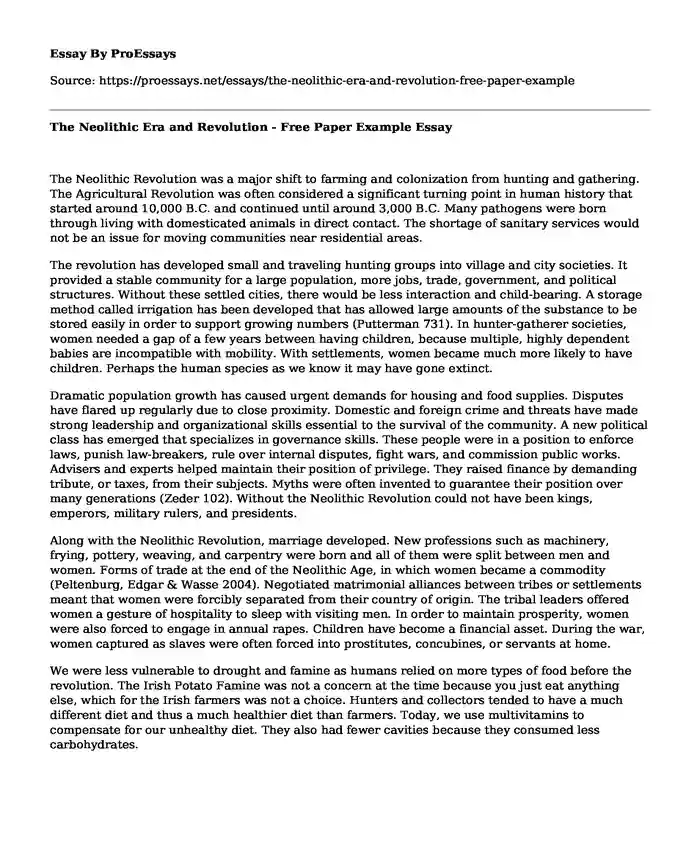The Neolithic Revolution was a major shift to farming and colonization from hunting and gathering. The Agricultural Revolution was often considered a significant turning point in human history that started around 10,000 B.C. and continued until around 3,000 B.C. Many pathogens were born through living with domesticated animals in direct contact. The shortage of sanitary services would not be an issue for moving communities near residential areas.
The revolution has developed small and traveling hunting groups into village and city societies. It provided a stable community for a large population, more jobs, trade, government, and political structures. Without these settled cities, there would be less interaction and child-bearing. A storage method called irrigation has been developed that has allowed large amounts of the substance to be stored easily in order to support growing numbers (Putterman 731). In hunter-gatherer societies, women needed a gap of a few years between having children, because multiple, highly dependent babies are incompatible with mobility. With settlements, women became much more likely to have children. Perhaps the human species as we know it may have gone extinct.
Dramatic population growth has caused urgent demands for housing and food supplies. Disputes have flared up regularly due to close proximity. Domestic and foreign crime and threats have made strong leadership and organizational skills essential to the survival of the community. A new political class has emerged that specializes in governance skills. These people were in a position to enforce laws, punish law-breakers, rule over internal disputes, fight wars, and commission public works. Advisers and experts helped maintain their position of privilege. They raised finance by demanding tribute, or taxes, from their subjects. Myths were often invented to guarantee their position over many generations (Zeder 102). Without the Neolithic Revolution could not have been kings, emperors, military rulers, and presidents.
Along with the Neolithic Revolution, marriage developed. New professions such as machinery, frying, pottery, weaving, and carpentry were born and all of them were split between men and women. Forms of trade at the end of the Neolithic Age, in which women became a commodity (Peltenburg, Edgar & Wasse 2004). Negotiated matrimonial alliances between tribes or settlements meant that women were forcibly separated from their country of origin. The tribal leaders offered women a gesture of hospitality to sleep with visiting men. In order to maintain prosperity, women were also forced to engage in annual rapes. Children have become a financial asset. During the war, women captured as slaves were often forced into prostitutes, concubines, or servants at home.
We were less vulnerable to drought and famine as humans relied on more types of food before the revolution. The Irish Potato Famine was not a concern at the time because you just eat anything else, which for the Irish farmers was not a choice. Hunters and collectors tended to have a much different diet and thus a much healthier diet than farmers. Today, we use multivitamins to compensate for our unhealthy diet. They also had fewer cavities because they consumed less carbohydrates.
The Technological Progress of Culture, Environmental Mitigation, and Modification
The expansion of global crops to new areas has moved into new crops all over the world. Europe's oats and Egypt's flax have been exchanged. Trade was still a part of hunter-collectors' societies, but it grew in depth and size with the growth of agriculture. Companies have a greater capacity to offer value-added goods with surplus food and freshly produced skilled crafts. Without the Neolithic other transformations, like the Industrial Revolution produced a lot of adverse environmental changes. Yet vast numbers of stripped trees were left owing to the Neolithic Revolution and the arid desert created by overfarming was to some degree in the Mediterranean.
Works Cited
Peltenburg, Edgar, and A. Wasse. "Neolithic revolution." New perspectives on Southwest Asia in light of recent discoveries on Cyprus (2004).
Putterman, Louis. "Agriculture, diffusion and development: Ripple effects of the neolithic revolution." Economica 75.300 (2008): 729-748.
Zeder, Melinda A. "After the revolution: postNeolithic subsistence in northern Mesopotamia." American Anthropologist 96.1 (1994): 97-126.
Cite this page
The Neolithic Era and Revolution - Free Paper Example. (2023, Dec 16). Retrieved from https://proessays.net/essays/the-neolithic-era-and-revolution-free-paper-example
If you are the original author of this essay and no longer wish to have it published on the ProEssays website, please click below to request its removal:
- The Lost Cause, the New South, the Agrarian Revolt Essay
- Annotated Bibliography on Gold Rush
- Contrabands During the Civil War Essay Example
- Political Personalities: Mahatma Gandhi Essay Example
- Essay Sample on 19th-Century Americans: Worries Over Volatility, Slavery, and Legacy
- Annotated Bibliography: The Decision to Use the Atomic Bomb in WWII
- Essay Example on Berlin Wall: Stopping the Exodus of East German Professionals







